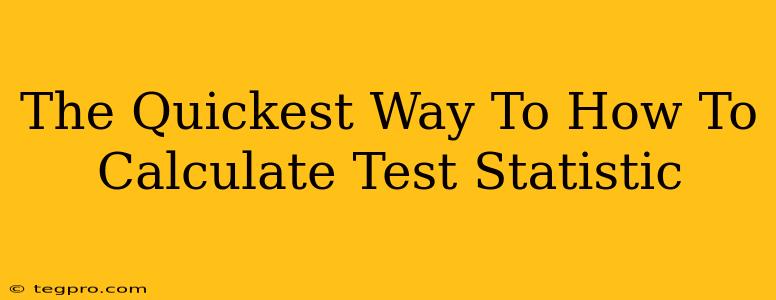Calculating a test statistic might sound intimidating, but it's a straightforward process once you break it down. This guide will show you the quickest way to calculate various common test statistics, focusing on understanding the underlying principles rather than getting bogged down in complex formulas. We'll cover the key steps and highlight crucial considerations. Remember, the specific test statistic you need depends on the type of hypothesis test you're conducting.
Understanding the Purpose of a Test Statistic
Before diving into calculations, let's clarify why we need a test statistic. In essence, it summarizes the evidence from your sample data to help you decide whether to reject your null hypothesis. The null hypothesis is your initial assumption (e.g., "there's no difference between groups"). The test statistic quantifies how far your sample results deviate from what you'd expect if the null hypothesis were true. A large deviation suggests the null hypothesis might be false.
Common Test Statistics and How to Calculate Them
Here's a breakdown of some frequently used test statistics:
1. Z-test (for comparing a sample mean to a population mean)
The Z-test is used when you know the population standard deviation. This is relatively rare in real-world scenarios, but understanding the Z-test is foundational.
Formula: Z = (sample mean - population mean) / (population standard deviation / √sample size)
Steps:
- Calculate the difference: Subtract the population mean from your sample mean.
- Calculate the standard error: Divide the population standard deviation by the square root of your sample size.
- Divide: Divide the difference (step 1) by the standard error (step 2). This gives you your Z-statistic.
Example: Imagine you're testing if the average height of students in a school is different from the national average (known population mean). You'd use the known national average height as your population mean, and your sample data (heights of students from the school) to compute the sample mean and then apply the formula.
2. t-test (for comparing a sample mean to a population mean or comparing two sample means)
The t-test is far more common than the Z-test because it uses the sample standard deviation when the population standard deviation is unknown.
Formula (One-sample t-test): t = (sample mean - population mean) / (sample standard deviation / √sample size)
Formula (Two-sample t-test, assuming equal variances): t = (mean1 - mean2) / √[(s_p² / n1) + (s_p² / n2)] where s_p² is the pooled variance.
Steps (One-sample t-test):
- Calculate the difference: Subtract the population mean from your sample mean.
- Calculate the standard error: Divide the sample standard deviation by the square root of your sample size.
- Divide: Divide the difference (step 1) by the standard error (step 2). This is your t-statistic.
Steps (Two-sample t-test): This involves calculating a pooled variance first, and then applying the formula. The process is slightly more complex, but statistical software readily performs this calculation.
3. Chi-Square Test (for analyzing categorical data)
The Chi-square test is used to determine if there's a significant association between categorical variables.
Formula: χ² = Σ [(Observed - Expected)² / Expected]
Steps:
- Create a contingency table: Organize your observed frequencies into a table.
- Calculate expected frequencies: Based on your null hypothesis (e.g., no association between variables), determine the expected frequencies for each cell in the table.
- Apply the formula: For each cell, subtract the expected frequency from the observed frequency, square the result, and divide by the expected frequency. Sum these values across all cells. The result is your Chi-square statistic.
Interpreting Your Test Statistic
The calculated test statistic is just one piece of the puzzle. To draw conclusions, you'll need to compare it to a critical value based on your chosen significance level (alpha, often 0.05) and the degrees of freedom (which depends on your test and sample size). This comparison will allow you to determine whether to reject or fail to reject your null hypothesis.
Leveraging Technology
While understanding the underlying principles is crucial, statistical software packages (like R, SPSS, Python with libraries like SciPy) significantly simplify the calculation process. These tools handle complex calculations efficiently, allowing you to focus on interpreting the results.
This guide provides a quick overview. Remember that the specific method depends on the type of data and the research question. Consulting statistical resources and seeking guidance from statisticians is always beneficial, especially for complex analyses.

